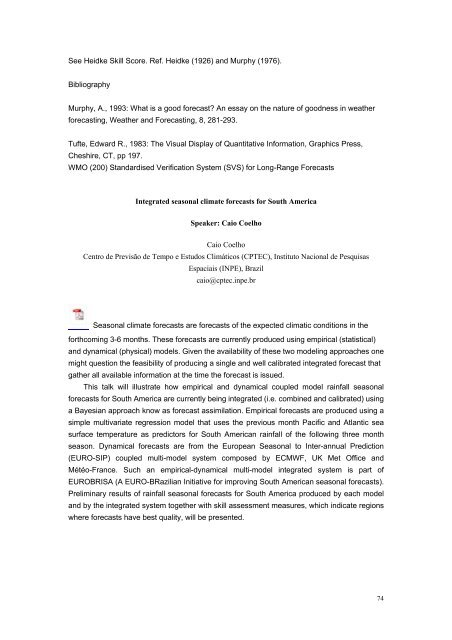The tenth IMSC, Beijing, China, 2007 - International Meetings on ...
The tenth IMSC, Beijing, China, 2007 - International Meetings on ...
The tenth IMSC, Beijing, China, 2007 - International Meetings on ...
You also want an ePaper? Increase the reach of your titles
YUMPU automatically turns print PDFs into web optimized ePapers that Google loves.
See Heidke Skill Score. Ref. Heidke (1926) and Murphy (1976).<br />
Bibliography<br />
Murphy, A., 1993: What is a good forecast? An essay <strong>on</strong> the nature of goodness in weather<br />
forecasting, Weather and Forecasting, 8, 281-293.<br />
Tufte, Edward R., 1983: <str<strong>on</strong>g>The</str<strong>on</strong>g> Visual Display of Quantitative Informati<strong>on</strong>, Graphics Press,<br />
Cheshire, CT, pp 197.<br />
WMO (200) Standardised Verificati<strong>on</strong> System (SVS) for L<strong>on</strong>g-Range Forecasts<br />
Integrated seas<strong>on</strong>al climate forecasts for South America<br />
Speaker: Caio Coelho<br />
Caio Coelho<br />
Centro de Previsão de Tempo e Estudos Climáticos (CPTEC), Instituto Naci<strong>on</strong>al de Pesquisas<br />
Espaciais (INPE), Brazil<br />
caio@cptec.inpe.br<br />
Seas<strong>on</strong>al climate forecasts are forecasts of the expected climatic c<strong>on</strong>diti<strong>on</strong>s in the<br />
forthcoming 3-6 m<strong>on</strong>ths. <str<strong>on</strong>g>The</str<strong>on</strong>g>se forecasts are currently produced using empirical (statistical)<br />
and dynamical (physical) models. Given the availability of these two modeling approaches <strong>on</strong>e<br />
might questi<strong>on</strong> the feasibility of producing a single and well calibrated integrated forecast that<br />
gather all available informati<strong>on</strong> at the time the forecast is issued.<br />
This talk will illustrate how empirical and dynamical coupled model rainfall seas<strong>on</strong>al<br />
forecasts for South America are currently being integrated (i.e. combined and calibrated) using<br />
a Bayesian approach know as forecast assimilati<strong>on</strong>. Empirical forecasts are produced using a<br />
simple multivariate regressi<strong>on</strong> model that uses the previous m<strong>on</strong>th Pacific and Atlantic sea<br />
surface temperature as predictors for South American rainfall of the following three m<strong>on</strong>th<br />
seas<strong>on</strong>. Dynamical forecasts are from the European Seas<strong>on</strong>al to Inter-annual Predicti<strong>on</strong><br />
(EURO-SIP) coupled multi-model system composed by ECMWF, UK Met Office and<br />
Météo-France. Such an empirical-dynamical multi-model integrated system is part of<br />
EUROBRISA (A EURO-BRazilian Initiative for improving South American seas<strong>on</strong>al forecasts).<br />
Preliminary results of rainfall seas<strong>on</strong>al forecasts for South America produced by each model<br />
and by the integrated system together with skill assessment measures, which indicate regi<strong>on</strong>s<br />
where forecasts have best quality, will be presented.<br />
74






![final_program_abstracts[1]](https://img.yumpu.com/19102520/1/174x260/final-program-abstracts1.jpg?quality=85)









